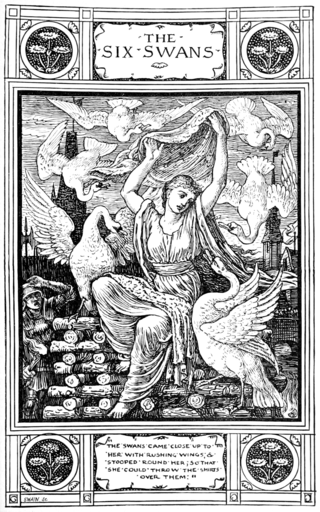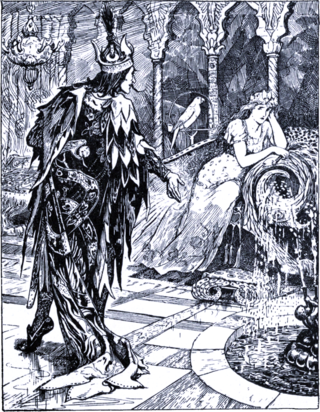Plot summary
The Queen of the Fairies having died, the fairies tried to elect a new one, but there were two candidates they could not choose between. They decided whoever did the greatest wonder would be queen. One, Surcantine, resolved to raise a prince whom nothing could make constant, and the other, Paridamie, a princess whom no one would see without falling in love.
Nearby, King Bardondon and Queen Balanice had an infant daughter, Rosanella. One day the queen dreamed that an eagle had snatched a bouquet of roses from her, and when she woke, the princess had vanished. Soon after, peasant girls brought her twelve baskets, saying they might prove a consolation. Each one contained a beautiful baby girl. This renewed the queen's grief, but she set about providing for them, and this distracted her. She named them, but as they grew, though all were beautiful, intelligent, and accomplished, their dispositions were so clear that they came to be called by them: Sweet, or Grave, or Beautiful.
Meanwhile, Surcantine raised Prince Mirliflor to be perfect in every way except his fickleness, and he broke every heart in his father's kingdom. He went to visit King Bardondon and found himself in love with all twelve of the maidens, but one day giants carried them all off. The prince despaired, but soon after Paridamie appeared with Rosanella, and told the queen that soon she would not miss her twelve maidens. The prince did not want to meet her, but he had to, and found that she combined in herself all the charms of the twelve, and asked her to marry him.
Paridamie appeared, and revealed that the twelve had in fact all been Rosanella, so that they might charm the prince separately and, combined again, cure Mirliflor of his inconstancy. Surcantine owned herself defeated, and even attended the wedding and gave them a gift.

"Snow White" is a German fairy tale, first written down in the early 19th century. The Brothers Grimm published it in 1812 in the first edition of their collection Grimms' Fairy Tales, numbered as Tale 53. The original German title was Sneewittchen; the modern spelling is Schneewittchen. The Grimms completed their final revision of the story in 1854, which can be found in the 1857 version of Grimms' Fairy Tales.
Cinderella Op. 87, is a ballet composed by Sergei Prokofiev to a scenario by Nikolai Volkov. It is one of his most popular and melodious compositions, and has inspired a great many choreographers since its inception. The piece was composed between 1940 and 1944. Part way through writing it Prokofiev broke off to write his opera War and Peace. The premiere of Cinderella was conducted by Yuri Fayer on 21 November, 1945, at the Bolshoi Theatre, with choreography by Rostislav Zakharov and Galina Ulanova in the title role. Cinderella is notable for its jubilant music, lush scenery, and for the comic double-roles of the stepmother and the two stepsisters, more mad than bad in this treatment.

"The Goose Girl" is a German fairy tale collected by the Brothers Grimm and first published in Grimm's Fairy Tales in 1815. It is of Aarne-Thompson type 533.

"The Twelve Dancing Princesses" is a German fairy tale collected by the Brothers Grimm and published in Grimm's Fairy Tales in 1815. It is of Aarne-Thompson type 306.

"The Six Swans" is a German fairy tale collected by the Brothers Grimm in Grimm's Fairy Tales in 1812. It is of Aarne–Thompson type 451, commonly found throughout Europe. Other tales of this type include The Seven Ravens, The Twelve Wild Ducks, Udea and her Seven Brothers, The Wild Swans, and The Twelve Brothers. Andrew Lang included a variant of the tale in The Yellow Fairy Book.

"Kate Crackernuts" is a Scottish fairy tale collected by Andrew Lang in the Orkney Islands and published in Longman's Magazine in 1889. Joseph Jacobs edited and republished the tale in his English Fairy Tales (1890). The tale is about a princess who rescues her beautiful sister from an evil enchantment and a prince from a wasting sickness caused by dancing nightly with the fairies. The tale has been adapted to a children's novel and a stage play.

"The Blue Bird" is a French literary fairy tale by Madame d'Aulnoy, published in 1697. An English translation was included in The Green Fairy Book, 1892, collected by Andrew Lang.

Graciosa and Percinet is a French literary fairy tale by Madame d'Aulnoy. Andrew Lang included it in The Red Fairy Book.
Fairy Gifts is a French literary fairy tale, by the Comte de Caylus (1692–1765). Andrew Lang included it in his The Green Fairy Book.
King Kojata or The Unlooked for Prince or Prince Unexpected is a Slavonic fairy tale, of Polish origin. Louis Léger remarked that its source was "one of the most important collections of Polish literature".
The Little Good Mouse is a French literary fairy tale written by Madame d'Aulnoy. Andrew Lang included it in The Red Fairy Book.

Finette Cendron is a French literary fairy tale written by Madame d'Aulnoy.
Babiole is a French literary fairy tale, written by Madame d'Aulnoy. In English publications, the name is sometimes translated as Babiola.

The Wizard King is a French fairy tale published in Les fees illustres by the Chevalier de Mailly. Andrew Lang included it in The Yellow Fairy Book.
"The Twelve Huntsmen" is a German fairy tale collected by the Brothers Grimm as tale number 67 in their Grimm's Fairy Tales. Andrew Lang included it in The Green Fairy Book.
The Imp Prince is a French fairy tale written by Marie Catherine d'Aulnoy and published in her book Fairy Tales in 1697.

The Practical Princess and Other Liberating Fairy Tales is a collection of six short stories, written by Jay Williams, in 1979, and published by Hippo from Scholastic. Each story features nods in some way to classic Fairy tales.
Fairer-than-a-Fairy is a literary fairy tale published anonymously in the 1718 fairy tale collection Nouveaux contes de fées. It is attributed to the Chevalier de Mailly. Andrew Lang included it in The Yellow Fairy Book.
Princess Aubergine is an Indian folktale collected by Flora Annie Steel and sourced from the Punjab region. It concerns a princess whose lifeforce is tied to a necklace, and, as soon as it falls in the hand of a rival, the princess falls into a death-like sleep - comparable to heroines of European fairy tales Snow White and Sleeping Beauty. Variants exist in India, both with a heroine and a hero whose life is attached to a magical necklace.
The Anar Pari, or Pomegranate Fairy is an Indian folktale collected by Alice Elizabeth Dracott from Simla. The tale is a local form of tale type ATU 408, "The Love for Three Oranges", of the international Aarne-Thompson-Uther Index. As with The Three Oranges, the tale deals with a prince's search for a bride that lives in a fruit, who is replaced by a false bride and goes through a cycle of incarnations, until she regains physical form again. Variants are known across India with other species of fruits.
This page is based on this
Wikipedia article Text is available under the
CC BY-SA 4.0 license; additional terms may apply.
Images, videos and audio are available under their respective licenses.









